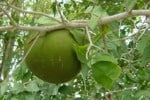The apricot (Prunus armeniaca) is a species of Prunus, classified with the plum in the subgenus Prunus. The native range is somewhat uncertain due to its extensive prehistoric cultivation.
It is a small tree, 8–12 m tall, with a trunk up to 40 cm diameter and a dense, spreading canopy. Theleaves are ovate, 5–9 cm long and 4–8 cm wide, with a rounded base, a pointed tip and a finely serrated margin. The flowers are 2–4.5 cm diameter, with five white to pinkish petals; they are produced singly or in pairs in early spring before the leaves. The fruit is a drupe similar to a smallpeach, 1.5–2.5 cm diameter (larger in some modern cultivars), from yellow to orange, often tinged red on the side most exposed to the sun; its surface is usually pubescent. The single seed is enclosed in a hard stony shell, often called a “stone”, with a grainy, smooth texture except for three ridges running down one side
Apricot is a fruit that has been known to humans for thousands of years. During archeological excavations in the antique Armenian town Shenchovit near Yerevan, apricot pits were found in layers dating back to over 6000 B.C. The first written mention of apricot, however, is in a Chinese letter more than 4000 years old.
Benefits
Apricots are rich in the antioxidant beta-carotene and rich in iron and potassium. It can help regulate blood pressure and is also high in soluble fibre.
Dried apricots should be eaten with foods that are rich in Vitamin C so that iron absorption can be increased.
Apricot – soft, sweet and juicy orange coloured fruit packed with beta-carotene.


Quintin
Great articles & Nice a site….
Patrick
thanks, your article is very informative.
Brenton
Wow! Thank you! I always wanted to write in my site something like that. Can I take part of your post to my blog?